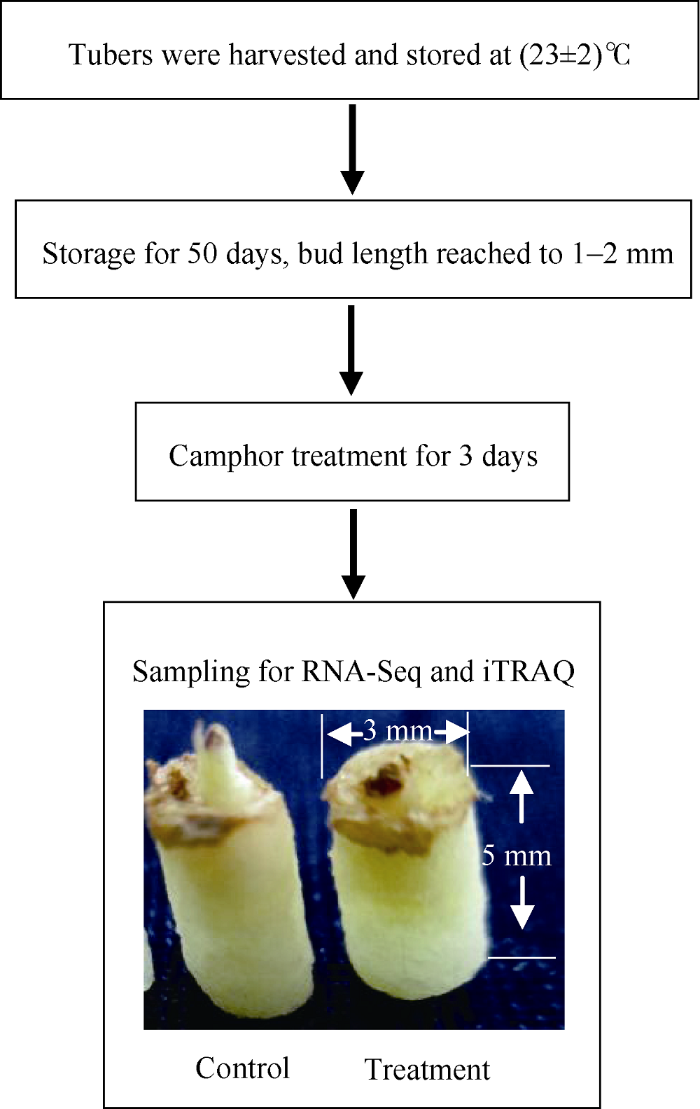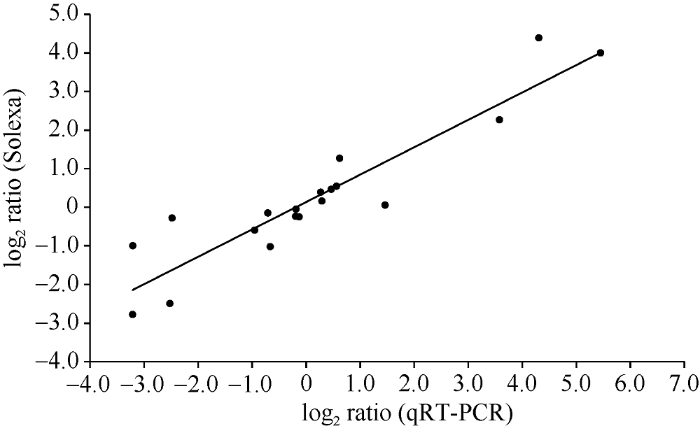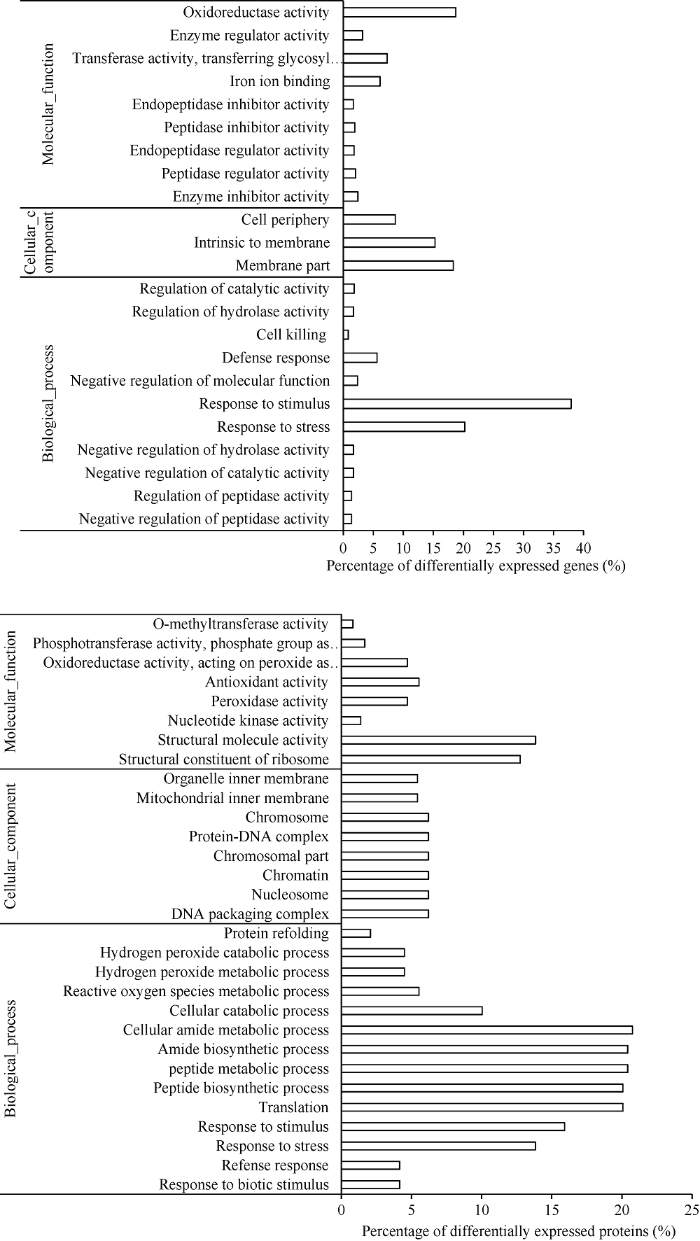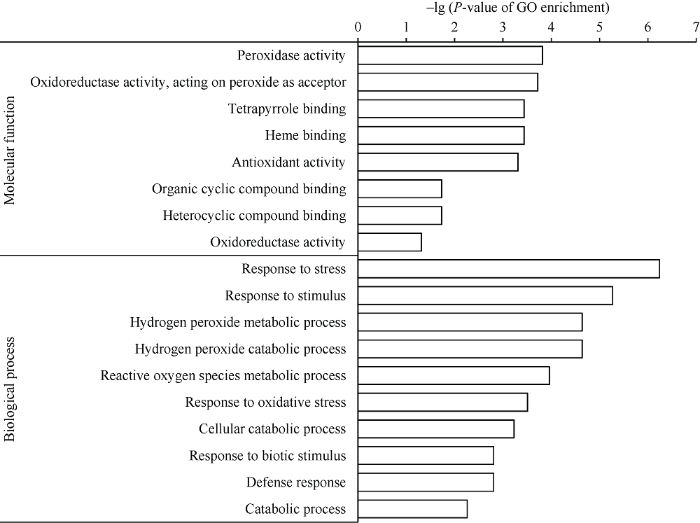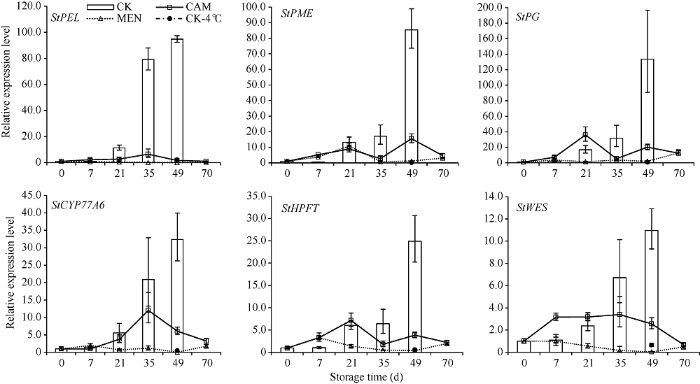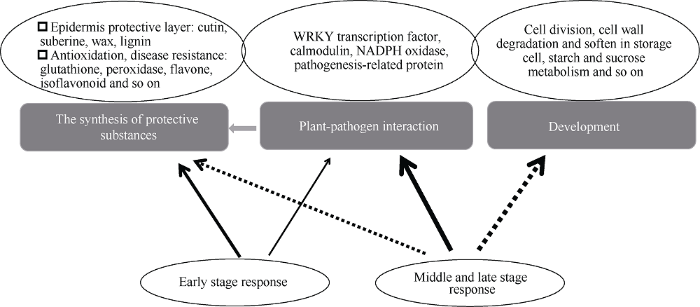两者的相关系数达0.94509/21/2024mt4复盘软件下载
时间:2024-09-21 02:20 来源:未知 作者:admin 点击:次
两者的相关系数达0.94509/21/2024mt4复盘软件下载马铃薯块茎过早萌芽会低落商品价格, 本试验斗劲挥发性物质的抑芽效应, 并从转录和卵白程度分解其影响机造。结果证明, 抑芽本领薄荷醇?樟脑?萘, 萌芽受抑低落代谢耗费, 薄荷醇管理180 d时的重量牺牲惟有对比牺牲的36%。樟脑管理萌芽块茎3 d惹起外达明显上调(或下调)的基因和卵白别离有1227 (299)和296 (204)个, 关键到场呼应刺激、防御反响。储藏时代, 果胶代谢基因的外达量随时分升高。樟脑早期分歧水平地刺激这些基因外达, 中后期则造止, 49 d时惟有对比的0.68%~23.35%。薄荷醇使上述基因外达保留低程度, 但可降低细胞周期负控基因外达受樟脑诱导并正在后期高外达。樟脑和薄荷醇均能造止滋长发育基因的外达, 变成芽去逝, 低落储藏损耗。前者早期能鼓吹合成袒护性物质, 萌芽时有更剧烈的抗菌反响; 后者则拦阻细胞星散。 马铃薯(Solanum tuberosumL.)顺应性强、产量安稳、养分统统, 既可菜用又能加工成薯条、薯片、面食等。种植马铃薯是困难地域脱贫增收的有用保障, 至2016年正在中邦的种植面积已达581.51万公顷, 总产9912.24万吨, 均列寰宇第一(FAO, 2016)。与水稻、小麦、玉米等籽粒型作物的种子比拟, 块茎水分含量高, 储藏期相对较短。种薯过早萌芽会变成薯块老化, 减产10%~30%[1]; 菜用或加工用, 薯块过早萌芽则耗费水分和养分物质, 低落商品价格。调控块茎萌芽, 裁汰储藏损耗, 耽误储藏期对工业康健生长至合主要。 分歧基因型的块茎息眠期各异, 息眠事后则萌芽, 2~5℃冷藏正在一按时分内可耽误息眠期但不行阻滞萌芽, 常需配合操纵抑芽剂来最大势限地耽误储藏期。目前用于加工、鲜食类块茎储藏的抑芽剂主倘使化学试剂氯苯胺灵(3-氯氨基甲酸异丙基酯, CIPC)。固然CIPC属低毒类物质, 但跟着人们对食物安闲的珍视, 市集可经受度不才降, 而且从1962年贸易化到目前已有50众年, 它的降解物以及对境况的交叉污染惹起越来越众的操心[23]。从植物挥发性物质中寻找操纵简单、无毒的绿色新型抑芽物质耽误块茎储藏, 是管理这一题目的志愿体例。斟酌证明, 从少少浓郁植物中提取的精油对马铃薯块茎萌芽具有分歧水平的造止影响。薄荷(Mentha haplocalyxL.)、芫荽(Coriandrum sativumL.)和尤加利(Myrtaceae eucalypteaeL.)精油管理马铃薯块茎10 d后均能分歧水平地延缓萌芽, 但后两种精油中含有的柠檬烯会惹起薯块洪量靡烂[4]。另有斟酌证明留兰香(Mentha spicataL.)精油及其关键因素R-香芹酮能造止马铃薯块茎萌芽以及线-二甲基萘是马铃薯息眠历程中自己发作的挥发性物质, 外源施用可造止萌芽, 但块茎外观残留量低落到1.4~2.7 mg kg-1时则会还原萌芽, 已说明该物质是通过降低细胞周期负控基因KRP1和KRP2的外达量, 拦阻细胞星散, 从而造止块茎萌芽[8910]。樟树叶中的关键因素樟脑(1,7,7-三甲基二环[2.2.1]庚烷-2-酮)对马铃薯块茎具有抑芽可逆效应, 分解块茎正在息眠、萌芽、樟脑管理50 d及还原萌芽4种状况下的转录组和卵白组区别, 出现它并没有耽误息眠状况, 而是使芽机合发作形似屈膝病原菌侵染的致死历程, 直接对芽变成毁伤[11], 因管理时分过长, 并不显露基因早期呼应情景。高通量测序技巧(high-throughput mRNA sequencing, RNA-seq)是统统解析特定条目下基因外达转折的有用器械, 欺骗该技巧共测得马铃薯息眠破除历程中的5912个区别外达基因, 个中滋长素、赤霉素、细胞星散素和油菜素内酯合成联系基因的过量外达占主导, 且追随困境呼应和氧化还原安排 。同位素标帜相对和绝对定量技巧(isobaric tags for relative and absolute quantification, iTRAQ)是目前卵白组学分解中行使成效较好的标帜技巧之一, 欺骗该本领从马铃薯块茎中判决出4453个卵白, 正在低温储藏糖化历程中出现46个区别外达卵白[13]。本试验选用萘(1,4-二甲基萘的形似物)、樟脑、薄荷醇(2-异丙基-5-甲基环己醇, 薄荷精油关键因素) 3种挥发性物质管理马铃薯, 斗劲它们对块茎的抑芽效应; 同时, 用樟脑管理萌芽块茎3 d, 测定转录组和卵白组, 开采早期呼应的合头基因和卵白; 依据组学分解, 连系基因外达量的转折幅度、基因的生物学意思和昔人合于息眠和萌芽斟酌, 采选涉及细胞壁和外皮物质合成、植物病原菌互作等心理历程中的12个基因, 检测储藏时代樟脑、薄荷醇管理对这些基因外达的影响。试验旨正在确认具有潜正在价格的抑芽物质, 初阶领悟其影响机造, 为马铃薯的绿色安闲储藏供给参考。 1.1 试验原料和试剂马铃薯短息眠种类‘费乌瑞它’(Favorita)原原种, 由四川农业大学农学院马铃薯斟酌斥地中央供给。2月底移栽试管苗于网室, 基质栽培, 于5月中下旬植株发黄时功劳。萘购自成都科龙化工试剂厂, 樟脑(纯度96%)、薄荷醇(纯度98%)购自Sigma-Aldrich。TRIzol购自Invitrogen, 反转录试剂盒RevertAid First Strand cDNA Synthesis购自Thermo。引物及荧光染料套装SGExcel FastSYBR Mixture购自生工生物工程(上海)股份有限公司。 挑选新收原原种(约7~10 g 粒-1), 常温下愈伤化14 d后以200 g L-1的量装入8 L密封硬纸盒。依据初筛结果, 设萘(Naphthalene, NAP)、樟脑(Camphor, CAM)、薄荷醇(Menthol, MEN) 3种试剂的浓度为0.2 g L-1, 别离称取固体颗粒用纱布包裹置盒中(不与薯块直接接触), 以不作任何管理为对比(CK)。每管理5盒, 于(23±2)℃室内储藏。从储藏0 d起, 每隔15~20 d查察统计个中3盒薯块萌芽情景并称重, 芽长赶过2 mm即以为该薯块已破除息眠而萌芽。考核每盒20个薯块的芽长, 统计时以1盒为具体估计打算均匀芽长和程序差(n= 3)。储藏0、7、21、35和49 d (此时CK的芽长众正在2 mm)时, 从节余2盒中别离取样冻存于-80℃用于1.4荧光定量检测, 樟脑和薄荷醇管理不断储藏至70 d时取样。取样体例为, 以顶芽芽眼为中央, 用直径3 mm硬质塑料管打孔, 取从外皮起5 mm的圆柱体。 如图1所示, 储藏到对比块茎芽长1~2 mm时, 用0.2 g L-1樟脑管理3 d后取样, 以顶芽芽眼为中央, 取直径3 mm, 高5 mm的圆柱体, 以8个圆柱体提取1管RNA或卵白, 为1个生物学反复, 各3反复, 送深圳华大基因科技任职有限公司和杭州景杰生物科技有限公司完结RNA-seq和iTRAQ测序分解, 将3次反复的RNA或卵白等量混淆后修库测序。
依据组学分解得回的区别基因和富集的代谢通道新闻以及合于块茎萌芽的文献报道[1011], 采选12个基因欺骗Oligo 6.0软件策画特异性引物(外1), RNA提取、荧光定量体例和估计打算本领同上。以储藏0 d时的ΔCt值为对比, 将3次试验反复所提的3管RNA混淆后反转录所得cDNA作3次荧光定量反复。 2.1 抑芽本领比照储藏50 d时各管理区别光鲜, CK有70.90%长出约2 mm完好小芽, 萘管理长出分解不单鲜的异常芽, 樟脑管理的芽顶端发黑坏死, 薄荷醇管理仅能睹到内部去逝机合(图2)。80 d时CK的芽长已达14.29 mm, 而萘管理使芽滋长受抑保留正在2 mm摆布, 樟脑管理的芽已齐备去逝, 薄荷醇管理的薯块正在总共储藏时代均无芽滋长(外2)。据此得出抑芽本领为薄荷醇樟脑萘。
外中数据为均匀值±程序差, 采用新复极差法举办众重斗劲, 统一列标注分歧巨细写字母的值别离正在0.01和0.05程度上区别明显, 缩写同图2。 储藏时代块茎的重量牺牲包含呼吸耗费、水分欺骗和散失等。息眠时代块茎重量牺牲小且各管理间区别不大, 跟着对比萌芽和芽滋长对养分物的耗费, 重量牺牲光鲜, 180 d时已达22.78% (外2)。3种物质对芽有分歧水平的造止影响, 裁汰了物质耗费, 使重量牺牲变缓。180 d时抑芽本领最强的是薄荷醇, 其牺牲率约惟有对比的1/3, 具有耽误块茎储藏期的潜力。 由上述结果可知, 3种物质均对芽的滋长具有直接造止效应, 萘的影响较弱, 薄荷醇的致死效应则太强, 于是采选樟脑作进一步斟酌。芽长1~2 mm是块茎破除息眠萌芽的标识, 前期体视镜检证明直接管理萌芽块茎3 d变成顶端褐化, 证实芽发端受造止, 试验检测此时的mRNA和卵白转折, 以寻找樟脑抑芽效应早期正在分子层面的影响。通过RNA-seq检测到23,553个基因, 个中有1227个基因外达明显上调, 299个明显下调; 用iTRAQ判决出2510个卵白, 管理共变成296个卵白明显上调, 204个明显下调。2.2.1 qRT-PCR验证测序结果 为验证RNA-seq测序结果的牢靠性, 采选19个基因举办qRT-PCR, 由图3可知, 两种体例检测到基因外达转折趋向形似, 联系系数达0.9260 , 证实RNA-seq得回的基因外达新闻具有较高的精确性和可托度。但qRT-PCR验证iTRAQ的卵白外达则纷歧致, 有2个基因的外达转折趋向正在转录和卵白层面上展示相反情景(结果未列出)。臆念卵白合成、加工妆点滞后于mRNA转录, 两者正在时分和空间上的区别变成转折趋向的分歧步, qRT-PCR不适适用于验证iTRAQ。
0.05)证明, 区别卵白关键正在膜和细胞边际, 具有氧化还原酶活性、糖基移动酶活性、铁离子连系等功效, 关键到场呼应刺激、威逼、防御反响等历程。与转录组新闻比拟, 卵白组可供给更下逛的新闻, 即直接起影响或受影响的卵白。区别卵白正在细胞器内膜、线粒体内膜、染色体等众个部位均有漫衍。与转录组结果形似, 这些卵白具有氧化还原酶活性、磷酸移动酶活性, 同样到场呼应刺激、威逼和防御反响。转录和卵白程度都证明樟脑惹起了芽呼应刺激、威逼和防御反响, 从分子程度上证据仅管理3 d即对芽发作了倒霉影响(图4)。
通过KEGG分解, 区别外达基因共富集到113个代谢通道, 个中18个达明显程度( 0.05),外3列出了前10个通道。除次生代谢物生物合成外, 植物病原菌互作通道富集的基因最众, 个中的病程联系卵白STH-2 、PR2和转录因子WRKY75正在mRNA和卵白程度都升高。谷胱甘肽代谢通道富集的24个基因中, 有 22个均编码谷胱甘肽S-移动酶并上调外达, 已知谷胱甘肽动作生物体内的一种主要抗氧化剂, 其关键影响是废除自正在基, 袒护卵白质和酶平分子中的巯基, 联系酶的mRNA上调能够合成更众的抗氧化物质。二苯乙烯、黄酮类化合物等植物次生代谢产品具有抗氧化、抑菌等众种心理活性[17]。本试验中, 樟脑管理使上调外达基因明显富集到异黄酮、二苯乙烯类、黄酮和黄酮醇的生物合成通道, 联系基因如大豆异黄酮7-O-葡糖基移动酶基因、类黄酮3’-单加氧酶基因、反式白藜芦醇-di-O-甲基移动酶基因的外达均极明显升高。由此臆念块茎最初通过鼓吹合成分歧品种的袒护性物质, 缓解管理惹起的活性氧零乱来应对威逼。 iTRAQ测得的区别卵白明显富集到8个代谢通道, 核糖体(ko03010)、苯丙素生物合成(ko00940)、过氧化物酶体(ko04146)等与袒护性次生物质合成、抗氧化联系通道中的卵白上升, 而到场寻常心理功效的泛素介导卵白水解(ko04120)、内质网卵白质加工(ko04141)等通道中的卵白降低, 证实管理3 d已影响到寻常的卵白代谢和心理功效。 2.2.3 区别卵白和mRNA合系分解 将iTRAQ检测到的2510个卵白正在转录组中举办合系分解, 个中458个区别卵白对应的mRNA没有明显转折, 32个转折一律, 10个转折相反, 又有78个仅正在mRNA程度转折, 也证实通过RNA-seq检测到的1526个明显外达转折的mRNA中, 仅有42个对应的卵白转折, 其余卵白则没有转折或没有检测到。 正在两程度转折趋向相像的基因关键到场呼应困境、刺激、氧化威逼、过氧化氢领悟代谢、防御反响等生物历程, 阐发过氧化物酶活性、抗氧化活性、氧化还原活性等功效(图5)。合系基因的KEGG分解证明, 樟脑短期管理关键惹起苯丙素生物合成(ko00940)通道中的大批基因外达上调, 联系卵白升高。已知苯丙素生物合成的代谢产品包含木质素合成所需单体, 如香豆醇、松泊醇、5-羟基松柏醇、芥子醇, 而木质素是袒护植物体的第一道防地外皮和细胞壁的主要构成物质。樟脑管理芽3 d使这些物质合成的酶外达量升高, 有利于外皮的合成和修复, 臆念是前期屈膝外源侵吞的主要呼应体例之一。
依据区别基因的转折幅度和关键富集的代谢通道新闻, 采选到场袒护性物质合成、滋长发育、植物病原菌互作的基因12个, 检测它们正在樟脑、薄荷醇管理下随储藏时分的转折形式, 进一步显然两种抑芽物质的影响效应。2.3.1 到场细胞壁代谢、外皮物质合成基因的外达 果胶是植物细胞壁的关键组成物质, 果胶裂解酶(PEL)、果胶酯酶(PME)和众聚半乳糖醛酸酶(PG)到场果胶代谢, 从而导致胞壁降解, 细胞区别, 机合软化。已知果实成熟历程中这些基因的外达量和酶活性明显升高, 使果实软化。块茎储藏历程中 、PG外达量随储藏时分升高, 并正在萌芽时抵达最高值, 别离为0 d时的94、85、133倍(图6), 证实块茎息眠破除历程追随薯肉储藏细胞的胞壁软化, 臆念这更利于物质运输和养分供应。
樟脑管理下, 这3个基因的外达量正在前期呈震荡转折, 跟着块茎破除息眠萌芽, 樟脑管理抑芽的同时使得这些基因的外达程度远低于同期对比, 49 d时惟有同期对比的1.77%、18.19%和15.17%, 但都高于0 d的外达量。证实樟脑管理使芽的滋长受抑, 对储藏细胞的养分需求裁汰, 是以到场胞壁软化的基因外达量正在储藏中后期没有疾速上升。薄荷醇管理下, 除 正在21 d时升至对比一概程度外, 其余光阴各基因的外达量均保留极低程度, 49 d时与仍处于息眠期的4℃储藏块茎的外达量形似。复活芽外皮角质层的造成合于防范水分裂失和抵御外界威逼至合主要, 角质层由角质、木栓、蜡质构成。 、HPFT、WES基因到场造成角质、木栓和蜡质。由图6可知, 这3个基因正在储藏时代的转折趋向仍是升高, 希奇正在储藏后期即息眠破除芽造成时。樟脑管理正在早期惹起这些基因外达量升高且高于同期对比, 7 d时HPFT和WES的外达量是同期对比的3.17倍和2.88倍, 但随时分填补, 这些基因的外达量没有不断升高, 而是保留稳定或降低, 正在35 d之后均低于同期对比。薄荷醇管理下, 除正在7 d外总共储藏时代都与0 d时的外达量形似或更低。臆念樟脑、薄荷醇管理正在早期分歧水平地刺激这些基因的外达上调, 以鼓吹袒护层物质合成, 屈膝外界威逼, 但随时分填补, 细胞布局受到败坏, 影响了这些物质合成, 继而加剧了芽去逝。2.3.2 滋长发育联系基因外达形式分解 由图7可知, 转录因子GATA4L的编码基因外达量随储藏时分呈线性上升, 两者的联系系数达0.9450, 证实它与块茎息眠破除和萌芽亲昵联系。樟脑管理除35 d外其余时分点的外达量与0 d的形似, 而薄荷醇管理则更剧烈地造止该基因外达, 总共储藏时代都惟有0 d时的2%~8%。
1-氨基环丙烷-1-羧酸氧化酶ACO是乙烯造成的合头酶, 随块茎息眠的破除 外达量升高, 到萌芽时为0 d的114倍(图7)。樟脑管理刺激该基因外达量提早升高, 7 d时抵达同期对比的8.58倍, 但之后没有进一步上升, 跟着对比外达量上升而低于同期对比, 到49 d时惟有对比的1.65%。而无萌芽迹象的薄荷醇管理中,ACO的外达量永远保留正在低程度。KRPs是细胞周期卵白激酶造止子, 负调控细胞星散。尽量樟脑造止萌芽, 但和对比比拟, 基因外达量正在储藏时代左近, 都呈降低趋向, 正在49 d时的外达量均降低到0 d时的1/10。薄荷醇管理使该基因外达量明显升高, 正在各时分点均高于同期对比(1.6~15.9倍)。跟着细胞星散负控基因KRP4的外达降低, 分朝气合细胞星散加疾使息眠破除而萌芽, 臆念薄荷醇通过降低KRP4的转录本, 起到拦阻细胞星散造止萌芽的影响。2.3.3 植物病原菌互作联系基因外达形式分解 前述分解证明区别外达基因和卵白到场防御反响, 采选植物病原菌互作通道中的3个基因, 分解它们正在储藏时代的外达转折特性。转录因子WRKY75通报MPK4信号, 诱导防御联系基因外达, 75的外达正在前期受樟脑和薄荷醇诱导, 21 d时别离升高至0 d的22.53倍和12.23倍, 但正在21 d后薄荷醇管理的WRKY75外达量降低并无间保留低程度, 而樟脑管理的WRKY75外达量则正在49 d时升高到0 d的100.55倍。STH-2属病程联系卵白(PRP), 本试验中STH-2转录本正在储藏时代无光鲜转折, 但樟脑管理刺激该基因上调外达, 7 d 即抵达0 d时的5.76倍, 正在49 d块茎萌芽时的外达量增到0 d的343倍, 薄荷醇管理对该基因也有必定诱导影响但不如樟脑的光鲜。呼吸氧发生氧化酶RBOH正在互作通道中受钙调卵白激酶激活, 产存正在性氧, 惹起过敏反响, 应答外界威逼[18]。正在储藏中、后期RBOH外达量升高并追随块茎息眠破除, 49 d萌芽时为0 d的6.87倍; 樟脑管理能刺激该基因上调外达, 正在各时分点均高于同期对比, 49 d时抵达最高值; 薄荷醇管理的最高值出目前第7天, 为0 d的17.76倍之后下调并保留较低程度(图8)。能够看出这3个基因正在储藏时代均受樟脑诱导外达, 而且都正在块茎萌芽时抵达最高值, 证实相合于息眠块茎, 这些基因更众地到场代谢更活泼的萌芽阶段对威逼的呼应, 跟着芽去逝回到低程度。与樟脑分歧的是, 薄荷醇能诱导RBOH基因正在息眠期高外达, 证实息眠期的块茎或者受到薄荷醇较大的刺激影响。
樟脑具有杀虫、消肿、止痛等众种医疗影响, 目前尚无正在植物抑芽方面的斟酌; 薄荷醇可用作饮料和糖果等的赋香剂, 2003岁首度出现它对离体芽有造止影响, 但没有后续斟酌和行使[19]。本试验证明, 这两种物质都能造止块茎萌芽, 而马铃薯自己的抑芽物质1,4-二甲基萘的形似物萘的抑芽本领则相对较弱。樟脑对块茎的抑芽效应可逆, 具有行使于种薯潜力; 薄荷醇的抑芽本领更强, 它自己也用于食物, 相对更安闲, 具有效于商品薯储藏的潜力。本试验采用自然挥发的管理体例, 所需试剂浓度较高, 下一步可通过雾化、熏蒸等本领, 加强试剂自己的附着功效来低落操纵浓度以裁汰本钱。樟脑持久管理薯块(50 d)关键惹起与滋长发育机合组成联系的基因下调外达 。本试验中, 樟脑管理芽3 d惹起的上调基因居众, 它们具有合成袒护性物质和抗氧化功效, 关键到场防御反响、呼应困境威逼。上述比照证明, 正在与抑芽物质接触早期, 芽机合主动应对威逼, 然后期芽机合已受侵吞乃至去逝, 滋长发育联系基因外达下调。无论是息眠如故萌芽阶段, 植物病原菌互作通道中的病程联系卵白STH2、PR2、转录因子WRKY75等的编码基因外达量都受樟脑诱导外达, 但萌芽阶段的外达量最高, 证实这些基因更众地到场代谢更活泼的萌芽阶段对威逼的呼应。合系分解除了找到卵白与mRNA转折相像的32个基因, 大批基因涌现出转折分歧步气象, 正在以qRT-PCR验证卵白测序结果时也出现两者转折分歧步, 这与马进等[20]以qRT-PCR验证iTRAQ不符的情景相像。拟南芥的天冬氨酸卵白酶猪笼草卵白酶基因正在分歧机合如叶片、茎、种子和豆荚均有外达, 以为这类卵白涉及众种功效如细胞步调性去逝、卵白前体加工、病害和困境抗性、叶片衰老等[21]。本试验中天冬氨酸卵白酶猪笼草卵白酶1转录下调而卵白升高, 臆念上述气象是转录和翻译正在时分上分歧步, 卵白后期加工妆点变成了其转折滞后于转录应答, 使得mRNA转折已趋于安稳或下调后, 卵白程度才上调以屈膝外界威逼。乙烯是植物的内源激素之一, 正在安排衰老、果实成熟以及器官零落等历程中阐发鼓吹影响 。Coleman和Dioxide[23]斟酌证明外源乙烯能低落块茎的零落酸含量, 鼓吹息眠的破除, Hartmann等[24]斟酌说明息眠块茎分朝气合活化与滋长素及乙烯信号转导、细胞周期调控等的转录转折亲昵联系。将乙烯和模范的催芽剂赤霉素联合管理马铃薯鼓吹长息眠种类萌芽[25]。本试验说明块茎储藏历程追随乙烯合成合头酶基因ACO外达量的百倍填补, 从mRNA程度验证乙烯合成是块茎破除息眠所经心理历程。乙烯可启动果实代谢产生质的转折, 如淀粉水解为糖、众聚半乳糖醛酸酶含量上升惹起的机合软化、香气因素的合成等, 是果实成熟的主要启动因子。用乙烯管理芒果、玫瑰花等均查察到PEL、PME基因转录本填补和酶活性升高及果胶增溶气象[2627]。马铃薯块茎息眠破除历程与果实成熟有形似之处, 两者都涉及淀粉的降解, 储藏细胞胞壁的软化和领悟等。本试验中乙烯合成合头酶ACO和果胶降解酶PEL、PME、PG外达量都跟着储藏时分而升高, 臆念块茎息眠破除历程中合成乙烯并鼓吹胞壁降解联系酶的基因外达, 加疾养分物质运输, 这或者也是储藏后期薯肉软化的原由之一。樟脑和薄荷醇管理造止了这些基因的外达使块茎细胞壁正在储藏时代保留更好地完好性, 有用低落水分裂失和保留薯块硬度。 属GATA转录因子家族, 已知拟南芥GATA家族成员有29个, 到场种子萌发、下胚轴伸长、叶序和花器官肇端、吐花和衰老等心理功效[28]。StGATA4L基因与拟南芥GATA家族中的AtGATA2、AtGATA4形似性最高, 但它们编码的氨基酸序列形似性也仅有50%。AtGATA2则能介导油菜素内酯和光信号的彼此交换, 到场样式修成[29]。通过统一造止子基因冷静技巧造止AtGATA4下逛靶基因转录, 转基因拟南芥正在缺氮威逼下有更高的根毛密度和结实的地上部, 以为AtGATA4到场根系发育[30]。本试验中StGATA4L外达量与块茎心理状况的更改亲昵联系, 它正在块茎萌芽中的影响以及正在功效上是否与拟南芥有形似性还必要进一步斟酌。KRPs通过造止活化的CYCD-CDKA复合物, 拦阻细胞星散由G1期向S期的过渡[31]。降低KRPs外达会变成滋长迟钝、器官变小、结实降低; 反之则植株器官、种子变大[3233]。Campbell等[10]欺骗芯片和定量RT-PCR说明马铃薯发作的挥发性抑芽物1,4-二甲基萘是通过填补KRP1和KRP2的转录本拦阻细胞星散抵达抑芽成效的。本试验中薄荷醇管理同样降低了KRP4的转录本, 并涌现出较强抑芽影响, 臆念两者有形似的影响机造。低浓度晚疫病菌孢子侵染时马铃薯STH-2卵白正在抗病种类中的升高速率疾于感病种类, 蕴蓄堆积量也高于后者, 将其归为病程联系卵白PRP, 但通过转基因技巧过量外达该基因并不行加强植株的晚疫病抗性, 但可降低马铃薯细胞对盐和分泌威逼的耐性 。比来的斟酌证明青枯病菌侵染时, STH-2卵白正在抗病种类中洪量蕴蓄堆积[37]。上述斟酌证实STH-2到场马铃薯生物和非生物威逼反响, 但的确功效和影响体例仍不显露。本试验中, 樟脑管理不只惹起萌芽块茎STH-2转录本和卵白程度极大的升高, 同时植物病原菌互作通道中的病程联系卵白PR2、转录因子WRKY75等108个基因转录程度也升高, 臆念该管理惹起块茎发作与屈膝病菌侵染形似的应答。通过上述分解, 以为樟脑管理最初惹起防御反响, 使角质、蜡质等外皮袒护层物质和黄酮、谷胱苷肽等抗菌、抗氧化物质合成联系基因的外达上调, 屈膝困境威逼; 跟着樟脑管理侵犯的加剧, 这些物质合成基因的外达降低, 与滋长发育联系基因的外达受抑, 但植物病原菌互作通道中的各基因外达量进一步升高, 惹起与屈膝病原菌侵染形似的应激反响, 芽慢慢坏死(图9)。薄荷醇管理的转折形式较为简单, 正在总共储藏时代外达量都较低, 除了惹起 和RBOH基因的外达量浮现出分歧于樟脑管理的升高, 证实它和樟脑的抑芽机造分歧。臆念它对细胞周期卵白的造止影响是阻滞块茎萌芽的主要原由, 而涉及的其他呼应基因和心理历程, 还需进一步斟酌。
实线箭头: 管理与同期对比比拟上调; 虚线箭头: 管理与同期对比比拟下调, 箭头粗细代外转折水平。 樟脑和薄荷醇均能造止滋长发育联系基因的外达, 使萌发的芽去逝, 低落储藏损耗。樟脑管理早期激励防御反响, 上调外达到场角质、抗氧化、抗菌等袒护性物质合成的基因; 萌芽时变成与屈膝病原菌形似的剧烈互作。薄荷醇降低KRP4外达拦阻细胞星散是分朝气合坏死的原由之一。 [1]肖合丽,郭华春. 纷歧心理年数马铃薯种薯芽中的内源激素含量转折及其对马铃薯植株滋长发育的影响植物心理学报 测定云南马铃薯主栽种类互帮88纷歧心理年数种薯芽中内源激素含量的 结果证明,跟着马铃薯种薯心理年数的填补,百般内源激素含量均呈降低趋向,心理年数30 d今后的种薯中,IAA、GA3、玉米素(ZR)和双氢玉米素(DHZR)降低明显,ABA降低相对迟钝;心理年数30 d的种薯,主茎长出的叶片数众,单株薯重高.
测定云南马铃薯主栽种类互帮88纷歧心理年数种薯芽中内源激素含量的 结果证明,跟着马铃薯种薯心理年数的填补,百般内源激素含量均呈降低趋向,心理年数30 d今后的种薯中,IAA、GA3、玉米素(ZR)和双氢玉米素(DHZR)降低明显,ABA降低相对迟钝;心理年数30 d的种薯,主茎长出的叶片数众,单株薯重高.
Marketplace preference for lower pesticide residues in foods has led to research to reduce the residue of chlorpropham (isopropyl N -3-chlorophenyl carbamate; CIPC), a postharvest-applied sprout inhibitor which is widely used around the globe to prevent sprouting of stored potatoes ( Solanum tuberosum L.). Ethylene gas, an effective, safe and non-toxic sprout inhibitor used in several countries, sometimes has negative effects on the colour of processed potato products when used alone. Trials were conducted over 302years using cv. Shepody (French fry) and cv. NorValley (potato chips/crisps) to determine whether a combination of these two sprout inhibitors, at reduced dosages, could inhibit sprouting while maintaining good processing colour. CIPC applied at 0, 0.1, 0.25 and 1.0 times the recommended dosage was combined with 402μll 611 of ethylene gas applied or no ethylene at all (0 ethylene), for 102day in 4 days, for 102day in 2 days or continuously, in a factorial design. Sprout inhibition in both cultivars was excellent at all levels of CIPC application except the 0 rate. In both cultivars, sprouting was inhibited by the continuous ethylene treatment. However, all levels of ethylene exposure except the 0 rate negatively affected processing colour in both cultivars. The darkening was dose dependent, whereby the colour was darkest in continuous ethylene and was less affected by the intermittent exposures. In continuous ethylene, the colour was progressively lighter during storage after initial darkening. Shepody tubers appeared to be more sensitive to ethylene than the NorValley tubers. In Shepody only, colour in the ethylene of 102day in 4 days treatments was progressively darker with increasing time in storage.
The replacement of synthetic chemical compounds Used as potato sprout inhibitors with naturally occurring compounds has been studied in potato varieties used in the processing industry. Sprout suppressant capacity of caraway (Carum carvi, L.), peppermint (Mentha piperita, L.), coriander (Coriandrum sativum, L) and eucalyptus (Eucalyptus globulus, Labill.) essential oils was studied and compared to the sprout suppressant capacity of chlorpropham (CIPC). For the particular conditions of this study, which used high concentrations, peppermint and coriander essential oils were the most effective sprout inhibitors with inhibition rates of more from 65 to 95% respect to their control. The use of these essential oils also prevented phytopathogenic damage. Analytical quality parameters, such as moisture content and total soluble solids, were not affected by treatment with any of the aromatic essential oils. Sensory analysis revealed no difference in appearance and taste between potatoes treated with essential oils and untreated tubers. (C) 2013 Elsevier B.V. All rights reserved.
Carvone was recently launched as a sprout inhibitor for potatoes in the Netherlands under the trade name “Talent”.
S-Carvone, a common monoterpene found in caraway (Carum carvi L.), inhibits the sprouting of potatoes very efficiently at continuous low head space concentrations. The length growth of potato sprouts was inhibited within 2 days following exposure to S-carvone. Sprouts were able to convert S-carvone into more reduced compounds. In addition, growth of the plant-pathogenic fungi Fusarium solani and Fusarium sulphureum was found to be inhibited by S-carvone at concentrations between 1 and 3 mM. At sub-inhibitory concentration, both F. solani and F. sulphureum converted S-carvone into more reduced compounds which were shown to be less toxic as compared to S-carvone. Finally, the growth rate of Streptococcus thermophilus, Lactococcus lactis and Escherichia coli decreased at S-carvone concentrations above 1 mM. This decrease correlated with a dissipation of the proton motive force generated in these cells.
Sprouting of potatoes during storage, due to tuber dormancy release, is associated with weight loss and softening. Sprout-preventing chemicals, such as chlorpropham (CIPC), can negatively impact the environment and human health. Monthly thermal fogging with mint (Mentha spicata L.) essential oil (MEO) inhibited sprouting in eight potato cultivars during large-volume 6-month storage: the tubers remained firm with 38% lower weight loss after 140 days of storage. The sprout-inhibitory action may be nullified: treated tubers washed with water resumed sprouting within days, with reduced apical dominance. MEO application caused local necrosis of the bud meristem, and a few weeks later, axillary bud (AX) growth was induced in the same sprouting eye. MEO components analysis showed that 73% of its content is the monoterpene R-carvone. Tubers treated with synthetic R-carvone in equivalent dose, 4.5 l l-1, showed an inhibitory effect similar to that of MEO. Surprisingly, 0.5 l l-1 of MEO or synthetic R-carvone catalyzed AX sprouting in the tuber. To the best of our knowledge, this is the first report of an essential oil vapor inducing early sprouting of potato tubers. R-carvone caused visible damage to the meristem membrane at sprout-inhibiting, but not sprout-inducing doses, suggesting different underlying mechanisms. After 5 days exposure to R-carvone, its derivatives transcarveol and neo-dihydrocarveol were found in buds of tubers treated with the inhibitory dose, suggesting biodegradation. These experiments demonstrate the potential of MEO vapor as an environmentally friendly alternative to CIPC in stored potatoes and as a research tool for the control of sprouting in plants.
Research on new sprout control methods led to the discovery of 1,4dimethylnaphthalene (1,4DMN) in the late 1970s. This compound has been registered in the USA since 1996 as a reduced risk chemical for use on stored potatoes for the purpose of sprout suppression. Relatively little is known about the levels of tuber residues required to maintain sprout suppression. The objective of this study was to identify the minimum 1,4DMN tuber residue levels above which sprout growth was inhibited. Using modified steel drums to store and treat potatoes, rates of 00208L02kg 611 to 560208L02kg 611 1,4DMN were applied to non-dormant, slightly “peeping” seed tubers of four different cultivars (Russet Burbank, Russet Norkotah, Shepody and FL1879) stored at 15 C65±652C. Tubers were treated by dribbling 1,4DMN onto a gauze that was placed on top of a return air pipe that re-circulated forced air inside the drum. Higher application rates resulted in higher 1,4DMN residues and longer suppression of sprout growth. Sprout growth was controlled for more than 5002days for all cultivars in both years for tubers treated at the highest rate. The duration of sprout inhibition corresponded with the time it took for tuber residues to drop below an estimated residue level of 1.4–2.102ppm, for R. Burbank, Shepody and FL1879, and 2.702ppm for Russet Norkotah. Below these levels, sprouting was no longer suppressed and resumed for all cultivars.
The suppression of sprout growth is critical for the long-term storage of potato tubers. 1,4-Dimethylenapthlene (DMN) is a new class of sprout control agent but the metabolic mode of action for this compound has yet to be elucidated. Changes in transcriptional profiles of meristems isolated from potato tubers treated with the DMN were investigated using an Agilent 44 K 60-mer-oligo microarray. RNA was isolated from nondormant Russet Burbank meristems isolated from tubers treated with DMN for 3 days or activated charcoal as a control. RNA was used to develop probes that were hybridized against a microarray developed by the Potato Oligo Chip Initiative. Analysis of the array data was conducted in two stages: total array data was examined using a linear model and the software Limma and pathway analysis was conducted by linking the potato sequences to the Arabidopsis thaliana . DMN elicited a change in a number of transcripts associated with cold responses, water regulation, salt stress, and osmotic adjustment. DMN also resulted in a repression of cyclin or cyclin-like transcripts. DMN also resulted in a 50% decrease in thymidine incorporation suggesting a repression of the S phase of the cell cycle. Quantitative real-time polymerase chain reaction analysis demonstrated that DMN increased transcripts for the cell cycle inhibitors KRP1 and KRP2. We conclude the DMN results in alteration of genes associated with the maintenance of a G1/S phase block possibly through the induction of the cell cycle inhibitors KRP1 and KRP2.
Sprouting regulation in potato tubers is important for improving commercial value and producing new plants. Camphor shows flexible inhibition of tuber sprouting and prolongs the storage period of potato, but its underlying mechanism remains unknown. The results of the present study suggest that camphor inhibition caused bud growth deformities and necrosis, but after moving to more ventilated conditions, new sprouts grew from the bud eye of the tuber. Subsequently, the sucrose and fructose contents as well as polyphenol oxidase (PPO) activity were assessed after camphor inhibition. Transcription and proteomics data from dormancy (D), sprouting (S), camphor inhibition (C), and recovery sprouting (R) samples showed changes in the expression levels of approximately 4000 transcripts, and 700 proteins showed different abundances. KEGG (Kyoto encyclopaedia of genes and genomes) pathway analysis of the transcription levels indicated that phytohormone synthesis and signal transduction play important roles in tuber sprouting. Camphor inhibited these processes, particularly for gibberellic acid, brassinosteroids, and ethylene, leading to dysregulation of physiological processes such as cutin, suberine and wax biosynthesis, fatty acid elongation, phenylpropanoid biosynthesis, and starch and sucrose metabolism, resulting in bud necrosis and prolonged storage periods. The KEGG pathway correlation between transcripts and proteins revealed that terpenoid backbone biosynthesis and plant 損athogen interaction pathways showed significant differences in D vs. S samples, but 13 pathways were remarkably different in the D vs. C groups, as camphor inhibition significantly increased both the transcription levels and protein abundance of pathogenesis-related protein PR-10a (or STH-2), the pathogenesis-related P2-like precursor protein, and the kirola-like protein as compared to sprouting. In recovery sprouting, these genes and proteins were decreased at both the transcriptional level and in protein abundance. It was important to find that the inhibitory effect of camphor on potato tuber sprout was reversible, revealing the action mechanism was similar to resistance to pathogen infection. The present study provides a theoretical basis for the application of camphor in prolonging seed potato storage.
Potato tuber dormancy release is a critical development process that allows potato to produce new plant. The first Illumina RNA sequencing to generate the expressed mRNAs at dormancy tuber (DT), dormancy release tuber (DRT) and sprouting tuber (ST) was performed. We identified 26,639 genes including 5,912 (3,450 up-regulated while 2,462 down-regulated) and 3,885 (2,141 up-regulated while 1,744 down-regulated) genes were differentially expressed from DT vs DRT and DRT vs ST. The RNA-Seq results were further verified using qRT-PCR. We found reserve mobilization events were activated before the bud emergence (DT vs DRT) and highlighted after dormancy release (DRT vs ST). Overexpressed genes related to metabolism of auxin, gibberellic acid, cytokinin and barssinosteriod were dominated in DT vs DRT, whereas overexpressed genes involved in metabolism of ethylene, jasmonate and salicylate were prominent in DRT vs ST. Various histone and cyclin isoforms associated genes involved in cell division/cycle were mainly up-regulated in DT vs DRT. Dormancy release process was also companied by stress response and redox regulation, those genes related to biotic stress, cell wall and second metabolism was preferentially overexpressed in DRT vs ST, which might accelerate dormancy breaking and sprout outgrowth. The metabolic processes activated during tuber dormancy release were also supported by plant seed models. These results represented the first comprehensive picture of a large number of genes involved in tuber dormancy release process.
Abstract Cold-induced sweetening in potato tubers is a costly problem for the food industry. To systematically identify the proteins associated with this process, we employed a comparative proteomics approach using isobaric, stable isotope coded labels to compare the proteomes of potato tubers after 0 and 5 months of storage at 5 C. We evaluated both high pH reverse phase (hpRP) liquid chromatography (LC) and off-gel electrophoresis (OGE) as first dimension fractionation methods followed by nanoLC-MS/MS, using two high performance mass spectrometry platforms (Q-TOF and Orbitrap). We found that hpRP-LC consistently offered better resolution, reduced expression ratio compression, and a more MS-compatible workflow than OGE and consistently yielded more unique peptide/protein identifications and higher sequence coverage with better quantification. In this study, a total of 4463 potato proteins were identified, of which 46 showed differential expressions during potato tuber cold storage. Several key proteins important in controlling starch-sugar conversion, which leads to cold-induced sweetening, as well as other proteins that are potentially involved in this process, were identified. Our results suggest that the hpRP-RP shotgun approach is a feasible and practical workflow for discovering potential protein candidates in plant proteomic analysis.
Abstract Potato (Solanum tuberosum L.) is the worlds most important non-grain food crop and is central to global food security. It is clonally propagated, highly heterozygous, autotetraploid, and suffers acute inbreeding depression. Here we use a homozygous doubled-monoploid potato clone to sequence and assemble 86% of the 844-megabase genome. We predict 39,031 protein-coding genes and present evidence for at least two genome duplication events indicative of a palaeopolyploid origin. As the first genome sequence of an asterid, the potato genome reveals 2,642 genes specific to this large angiosperm clade. We also sequenced a heterozygous diploid clone and show that gene presence/absence variants and other potentially deleterious mutations occur frequently and are a likely cause of inbreeding depression. Gene family expansion, tissue-specific expression and recruitment of genes to new pathways contributed to the evolution of tuber development. The potato genome sequence provides a platform for genetic improvement of this vital crop. 2011 Macmillan Publishers Limited. All rights reserved
邹雪,邓孟胜,李立芹,余金龙,丁凡,黄雪丽,彭洁,帅禹,蔡诚诚,王西瑶. 油菜素内酯合成和信号转导基因正在马铃薯块茎储藏时代的外达转折及对萌芽的影响作物学报 为探明油菜素内酯BR正在块茎萌芽中的影响,作战更有用的种薯催芽调控体例,采选了息眠期分歧的3个种类,欺骗q RT-PCR分解与BR合成、信号转导、调控相合的9个基因正在储藏时代及抑芽管理下的外达形式;同时检测BR形似物24-外油菜素内酯(24-e BL)及其与赤霉素GA3对块茎萌芽的影响。结果证明,涉及BR合成的4个基因外达量均随储藏时分耽误升高,短息眠种类升高的时分点早于中、长息眠种类;信号转导及调控基因中BRI1和CYCD3的转折与合成基因形似,BSK和TCH4的外达量则正在中、长息眠期种类中保留恒定。抑芽管理正在储藏前期能刺激这些基因的外达升高,但之后都神速降低并保留低程度。转录因子BZR1正在百般类中以及抑芽管理下均没有光鲜转折。24-e BL利于块茎破除息眠,但不鼓吹芽的伸永生长,与GA3互配成效更佳,单株块茎增重37.92%~98.41%。结论证明,BR合成和信号转导是块茎从息眠向萌芽更改的必经心理历程,它与GA3互配用于催芽更利于种薯萌芽的齐截、结实并鼓吹块茎造成。
为探明油菜素内酯BR正在块茎萌芽中的影响,作战更有用的种薯催芽调控体例,采选了息眠期分歧的3个种类,欺骗q RT-PCR分解与BR合成、信号转导、调控相合的9个基因正在储藏时代及抑芽管理下的外达形式;同时检测BR形似物24-外油菜素内酯(24-e BL)及其与赤霉素GA3对块茎萌芽的影响。结果证明,涉及BR合成的4个基因外达量均随储藏时分耽误升高,短息眠种类升高的时分点早于中、长息眠种类;信号转导及调控基因中BRI1和CYCD3的转折与合成基因形似,BSK和TCH4的外达量则正在中、长息眠期种类中保留恒定。抑芽管理正在储藏前期能刺激这些基因的外达升高,但之后都神速降低并保留低程度。转录因子BZR1正在百般类中以及抑芽管理下均没有光鲜转折。24-e BL利于块茎破除息眠,但不鼓吹芽的伸永生长,与GA3互配成效更佳,单株块茎增重37.92%~98.41%。结论证明,BR合成和信号转导是块茎从息眠向萌芽更改的必经心理历程,它与GA3互配用于催芽更利于种薯萌芽的齐截、结实并鼓吹块茎形。 (责任编辑:admin) |
